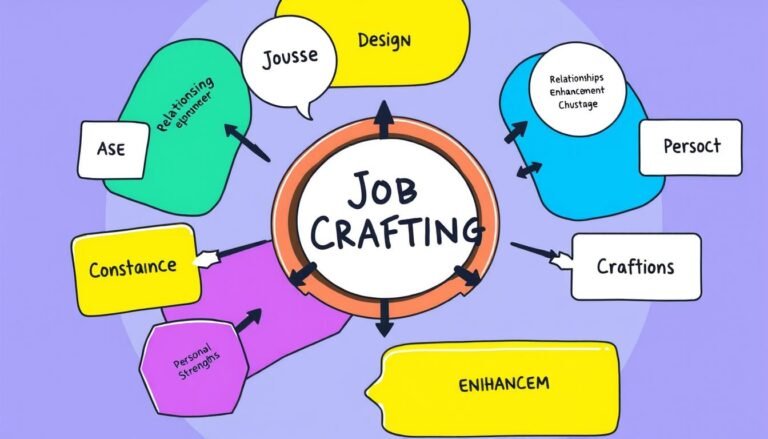How Group Behavior Impacts Organizational Success: A Psychologist’s Perspective
Ever wondered why some teams do great while others struggle? It all comes down to group behavior and its big role in success. As a psychologist, I’ve seen how people working together can either lift a company up or bring it down.
Group behavior is key in organizational psychology. It affects everything from daily tasks to big plans. It’s made up of individual traits, leadership, and company culture. Knowing these things is key for any business to succeed today.
Studies show group behavior has changed a lot since the 1990s. This change is thanks to globalization and new tech. Now, we’re studying things like cultural differences, diversity, and how people act in groups. These are all important for today’s businesses.
People act differently when they’re with others than when they’re alone. Group norms, or the unspoken rules, have a big impact on how we behave. They can help a group work together well or lead to bad decisions, like groupthink.
Key Takeaways
- Group behavior significantly influences organizational success
- Workplace dynamics have evolved due to globalization and technology
- Group norms play a crucial role in shaping individual behavior
- Understanding group dynamics is essential for effective leadership
- Diversity and cross-cultural factors are increasingly important in group behavior
- Phenomena like groupthink can impact organizational decision-making
Understanding Organizational Behavior
Organizational behavior studies how people act at work. It’s vital for companies to understand this to succeed. The definition of OB looks at how individuals and groups act in a business setting.
Definition and Importance
The role of OB is huge. It boosts employee and customer happiness, sparks new ideas, and raises productivity. Companies that focus on OB see better communication and stronger leadership.
Key Components of Organizational Behavior
OB includes motivation, communication, leadership, and decision-making. These parts shape how people work together and impact a company’s success. Knowing these helps businesses create a positive work place.
Evolution of Organizational Behavior Studies
The history of OB started in the late 1920s with the Hawthorne Studies. These studies found that social factors affect productivity more than environmental ones. Since then, OB has become a key part of business education and research.
Today, OB is essential in many business areas. It helps with hiring, training, and keeping employees engaged. By focusing on OB, companies can lower burnout and turnover, leading to a more stable and productive team.
The Psychology of Group Dynamics
Group dynamics are key to success in organizations. It’s important to understand group psychology and team behavior. This knowledge helps create productive work environments.
Research by Forsyth (2018) shows how crucial group dynamics are. Teams with poor communication struggle with misunderstandings and trust issues. But, diverse teams bring new ideas, boosting creativity and problem-solving.
- 63% of individuals conform to group norms, even when their personal beliefs differ
- Diverse groups outperform homogeneous ones by 33% in creativity and innovation
- Groups prioritizing effective communication see a 40% increase in successful decision-making
To better group dynamics, organizations can try a few things. Encourage open communication, organize team-building activities, and set clear goals. Good leadership and diversity are also key for positive team behavior.
| Factor | Impact on Group Dynamics |
|---|---|
| Trust | Increases idea sharing and collaboration |
| Diversity | Enhances innovation and decision-making |
| Communication | Reduces conflicts and improves understanding |
| Leadership | Guides group behavior and sets expectations |
By understanding social influence and group psychology, organizations can foster success. They can create environments that support positive team behavior.
Group Behavior: Foundations and Theories
Understanding group behavior is key for success in organizations. Let’s look at important theories that help us understand group dynamics and how they affect the workplace.
Social Identity Theory
Social identity theory explains why we see ourselves as part of a group. It says our sense of self comes from our group memberships. This theory helps us understand why we often favor our own group over others.
Group Cohesion
Group cohesion is how much members like being in their group. It’s what holds teams together. Groups with strong cohesion tend to be more productive and happy. Bruce Tuckman’s model shows five stages of group development: forming, storming, norming, performing, and adjourning.
Groupthink
Groupthink happens when everyone wants to agree too much. It can cause bad decisions because people don’t want to disagree. Leaders should encourage different views and open discussions to avoid groupthink.
These group behavior theories give managers valuable insights. By understanding social identity, building cohesion, and avoiding groupthink, organizations can create better teams. This leads to better performance overall.
| Theory | Key Concept | Impact on Organizations |
|---|---|---|
| Social Identity Theory | Self-concept from group membership | Influences team dynamics and loyalty |
| Group Cohesion | Forces keeping group together | Affects productivity and satisfaction |
| Groupthink | Consensus over critical thinking | Can lead to flawed decision-making |
Leadership and Its Impact on Group Behavior
Leadership is key in shaping group behavior in organizations. Leaders’ interactions with their teams greatly affect productivity, job satisfaction, and success.
Leadership Styles and Their Effects
Various leadership styles impact group behavior differently. Autocratic leaders might boost productivity but could lower creativity and job happiness. Democratic leaders, however, encourage teamwork and collaboration, leading to happier employees.
Transformational leadership, which inspires and motivates, has shown to greatly improve team performance and trust.
| Leadership Style | Effects on Group Behavior |
|---|---|
| Autocratic | High productivity, low creativity, low job satisfaction |
| Democratic | Increased teamwork, higher job satisfaction, potential for time-consuming decisions |
| Transformational | Improved team performance, increased employee satisfaction, enhanced commitment |
The Role of Emotional Intelligence in Leadership
Emotional intelligence is now a big deal in leadership studies. Leaders with high emotional intelligence can understand and manage their and their team’s emotions. This is vital for positive group dynamics, conflict resolution, and a harmonious work environment.
Studies reveal that emotionally intelligent leaders are better at engaging employees, promoting teamwork, and driving innovation. They build strong team relationships through understanding leader-member exchange, leading to better outcomes for the organization.
“Effective leaders use their emotional intelligence to create a positive work culture, which in turn influences group behavior and organizational success.”
In summary, leadership has a huge impact on group behavior. By choosing the right leadership style and developing emotional intelligence, leaders can greatly improve team performance and contribute to the success of the organization.
Communication Patterns in Groups
Group communication is key to success in organizations. Small groups have three or more people with a shared goal and identity. They are defined by their size, identity, and how they work together.
Good team work needs clear goals, skilled members, and a focus on results. Groups that make decisions together and hear different views do well. But, problems like social loafing can slow them down.
Knowing these styles can make groups work better. There’s also a system that breaks down communication into three main types:
| Communication Style | Description |
|---|---|
| Passive | Avoids conflict, often at personal expense |
| Assertive | Expresses needs clearly while respecting others |
| Aggressive | Forcefully pursues goals, may disregard others |
Passive-aggressive behavior mixes being passive and aggressive. It can mess up team work. Groups should talk openly and give clear feedback to fix this.
“Effective communication is the glue that holds organizations together.”
By understanding and adjusting to different communication styles, groups can do better. This helps them succeed as a team.
Decision-Making Processes in Organizational Groups
Group decision-making is key to success in organizations. Knowing the models, biases, and techniques helps achieve better results. Let’s dive into how groups make complex choices and the strategies they use to find the best decisions.
Group Decision-Making Models
Organizations use different models for group decisions. These include consensus, majority vote, and leader-decided methods. Studies show that majority rule works well. The best size for brainstorming groups is 5 to 9 people, offering a mix of views without being too big.
Biases in Group Decision-Making
Cognitive biases can greatly affect group decisions. Groupthink, where groups value harmony over critical thinking, is a big issue. The Challenger launch disaster is a clear example of what can happen when groupthink takes over.
Techniques for Improving Group Decisions
There are many ways to improve group decision-making:
- Nominal Group Technique: Encourages independent thinking and reduces the impact of dominant personalities.
- Delphi Method: Great for remote expert groups, using questionnaires to reach consensus.
- Dialectical Inquiry: Fosters debate between opposing teams to explore different views.
Diverse groups often come up with unique ideas and make more thorough decisions. Yet, it’s true that groups rarely do better than their best individual member.
| Technique | Key Benefit | Best Use Case |
|---|---|---|
| Nominal Group | Reduces dominant personality influence | Diverse team with varied expertise |
| Delphi Method | Allows for anonymous input | Remote expert groups |
| Dialectical Inquiry | Examines opposing viewpoints | Complex decisions with multiple stakeholders |
By grasping these organizational decision-making processes and using the right techniques, groups can overcome biases and make smarter choices.
Conflict Resolution and Group Behavior
Managing conflicts is key to a company’s success. Groups deal with different kinds of conflicts, like disagreements over tasks, personal issues, and how things are done. Using the right ways to solve disputes can turn these problems into chances for growth and new ideas.
Studies show that how teams handle conflicts greatly affects their performance. A study by Shabani et al. (2022) looked at how different conflict styles impact success in both private and public sectors. The Thomas-Kilman Instrument (TKI) model lists five main conflict management styles:
- Avoiding
- Competing
- Compromising
- Accommodating
- Collaborating
Each style fits different conflict situations. For example, compromise is good for finding a middle ground. Collaboration aims for solutions where everyone wins. The right approach depends on the situation and the team’s dynamics.
Good conflict resolution strategies can make teams perform better. Paul et al. (2004) discovered that collaborative styles help virtual teams, especially those with diverse cultures. This shows the need to adjust conflict management methods for different team settings.
| Conflict Type | Description | Resolution Approach |
|---|---|---|
| Task Conflict | Disagreements about work-related issues | Problem-solving, Collaboration |
| Relationship Conflict | Interpersonal tensions or personality clashes | Mediation, Team Composition Changes |
| Process Conflict | Disputes about how work should be done | Clarifying Roles, Establishing Procedures |
By knowing these conflict types and using the right solutions, companies can create better team environments. This leads to success through effective conflict management.
Diversity and Inclusion: Effects on Group Dynamics
Workplace diversity changes group dynamics in big ways. Studies show diverse teams bring new ideas, boosting creativity and solving problems better. A 2020 study in the Journal of Cleaner Production found that diverse boards help companies be more sustainable in Malaysia.
Benefits of Diverse Teams
Diverse teams have big advantages. They drive innovation and make better decisions. A study of 338 people in 75 teams across India showed how cultural differences make teams better. Another study with 288 members from 11 Beijing tech companies looked at gender in leadership.
Challenges in Managing Diverse Groups
Cultural differences can make communication hard. A study of 192 people from 27 countries found that different work styles affect team unity. Language and cultural norms can cause misunderstandings. Managers must find ways to make everyone feel included.
Strategies for Fostering Inclusive Group Behavior
Inclusion strategies are vital for making diversity work. Training on cultural awareness helps bridge gaps. Good communication is key, especially when working across cultures. Creating safe spaces where everyone feels valued improves team performance. By embracing differences, organizations can unlock the full potential of diverse teams.
| Diversity Factor | Impact on Team | Inclusion Strategy |
|---|---|---|
| Cultural Differences | Enhanced creativity | Cultural awareness training |
| Gender Diversity | Improved decision-making | Unconscious bias workshops |
| Age Diversity | Knowledge transfer | Mentorship programs |
Motivational Factors in Group Settings
Group motivation is key to success in any organization. Studies show how important workplace incentives and team engagement are. A big 69% of workers say they’d work harder if they felt appreciated.
Feeling valued makes employees up to 10 times more likely to feel part of the team. This connection is vital for a positive work environment. Also, 80% of staff work better when they’re rewarded for their efforts.
But rewards aren’t everything. Growth opportunities are also crucial. Last year, many US workers left because they didn’t see a chance to advance. Offering paths for growth can really motivate employees.
Leaders are essential in shaping the workplace culture. A culture of trust boosts performance and happiness. By creating inclusive cultures, leaders can build teams that are not just productive but also happy and loyal.
Source Links
- Group Behavior
- What Is Organizational Behavior?
- What Is Organizational Behavior (OB), and Why Is It Important?
- Understanding Organizational Behavior (Part 2) — Relationships within and between Teams
- Understanding Group Dynamics in the Workplace
- Psychology of Group Dynamics
- Complexities of Social Psychology and Group Dynamics
- Foundations of Group Behavior
- Foundations of Group Behavior
- Chapter 9 – Foundations of group behavior Notes | Knowt
- The Role of Leadership in Shaping Organizational Behaviour
- The Influence Of Leadership Styles On Group Behavior
- Chapter 8: Communicating in Groups and Organizations
- Behavioral Patterns and Communication Styles
- Group Decision Making Process: Tools & Techniques for Perfect Team Collaboration
- 11.4 Decision Making in Groups
- 10.4 Conflict Management
- The Influence of Conflict Management Styles on Group Decision Making
- Managing Conflict
- Diversity impact on organizational performance: Moderating and mediating role of diversity beliefs and leadership expertise
- 3 ways diversity can impact team dynamics – News & insight – Cambridge Judge Business School
- How can you manage group dynamics with diverse cultures in the workplace?
- 10 Factors That Influence Employee Motivation – PeopleThriver
- Work Motivation: The Roles of Individual Needs and Social Conditions
- Motivation in Groups







